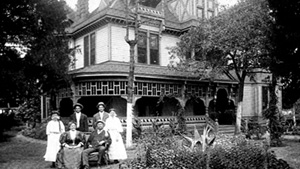By John H. Cochran
REALIZING the advantages to be gained by the successful navigation of the Trinity River, the early pioneers of Dallas County, in about 1852, built a raft, loaded it with cotton and placed Mr. Adam Haught in command, with instruction to take it to Galveston, as here-in-before stated, and prove the feasibility of the navigation of the Trinity River from Dallas to Galveston. Its success was such as to inspire hope to such an extent that people of Dallas never ceased their efforts in trying to induce some boat to come from Galveston to Dallas and thus demonstrate its practicability.
Their persistent efforts finally induced Captain J. M. McGarvey of the Job Boat No.1 , 66 x 20 ft, of 26 tons capacity to undertake the voyage, for which he received $500.00. This boat landed at Dallas some time in May, 1868. The coming of this boat enthused the people, not only of Dallas County, but of all counties bordering on the Trinity River and contiguous territory and filled them with enthusiasm and renewed hopes.
Contributions were soon made by the citizens of Dallas County and other bordering counties to clear the river of overhanging timber and remove the obstacles at Bois d’arc Island and other places that obstructed navigation. Confidence was so firmly established that business men of Dallas and other enthusiastic citizens soon raised enough money to build a boat. The builders were Crosby, Ballard and Ray. The boat was finished December 17, 1868. The boat was 87 x 20 ft, and was named “Sallie Haynes” in honor of the daughter of Dr. J. W. Haynes, a prominent merchant of Dallas and a large real estate owner. Miss Sallie Haynes afterwards became the wife of Barnett Gibbs. The arrival of the Job Boat No. 1 was the occasion of much rejoicing by the enthusiastic people, not only of Dallas, but other interested citizens of other counties.
I have no reliable account of the voyages of the “Sallie Haynes,” other than she reached Trinidad on April 18, 1869, and at Spivey’s Ferry she exchanged freight with the steamer “Early Bird,” from Galveston. The river was too narrow for these boats to pass each other, and after the exchange of cargoes, the “Sallie Haynes” proceeded as far down as Magnolia and from there turned back. I do not remember how many trips she made, but I am of the opinion she never made a round trip, and never reached Galveston. But the people of Dallas County and those bordering on the river, who realized that to insure cheap freight rates it was essential to have competitive water navigation of the Trinity River, such men as R. V. Tompkins, C. A. Keating, James Moroney, Henry Exall, J. Pink Thomas, W. C. Wolf, Col. Frank Holland, James B. Simpson, Capt Sidney Smith, John H. Cochran and Commodore S. W. S. Duncan and many others organized a company with C. A. Keating as president. This company undertook to raise $100,000 with which to operate, and finally induced the “Harvey” to come to Dallas as a help in securing Congressional aid for locks and dams.
Several bills were introduced in the Legislature for State aid; one which was drawn by Col. A. T. Raney of Anderson County, in the 18th Legislature, giving to any Company that would clear and clean the Trinity River so as to make it navigable for a given number of miles, four sections of land per mile thus cleared. When this bill came before the House for consideration, the member from Brazos County created considerable amusement as well as enemies by offering this amendment to the bill, to-wit: “Provided, that one-half of the land thus appropriated shall be used to bore artesian wells on the headwaters of the Trinity River furnish the necessary water.” Immediately Col. Raney wrote and offered an Amendment to the Amendment, which read, “Provided, the other half shall be fed to buy gimlets to bore the member from Brazos for the simples.” This did not add much to cement brotherly love between these gentlemen; but served its purpose in defeating the bill. Of course, neither of these amendments were recognized by the Speaker and never appeared on the Journals of the House.
From Dallas County
by John H. Cochran, 1927


